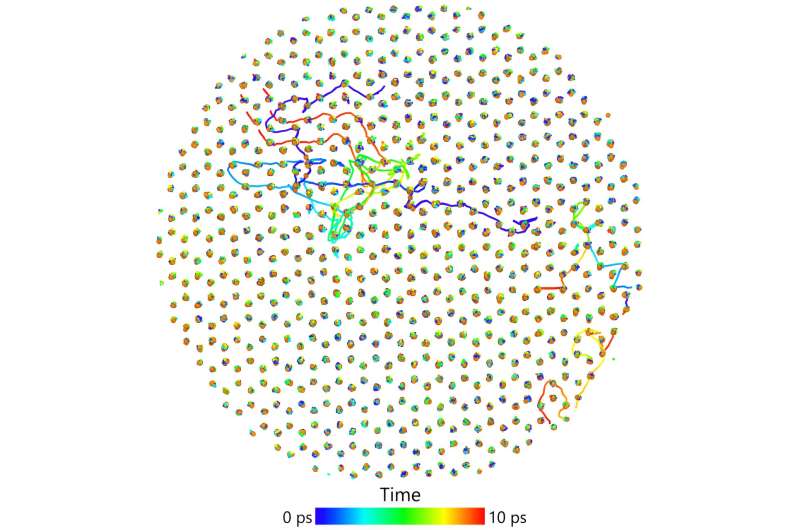This article has been reviewed according to Science X's editorial process and policies. Editors have highlighted the following attributes while ensuring the content's credibility:
fact-checked
peer-reviewed publication
trusted source
proofread
Iron atoms discovered on the move in Earth's solid inner core

The iron atoms that make up the Earth's solid inner core are tightly jammed together by astronomically high pressures—the highest on the planet.
But even here, there's space for wiggle room, researchers have found.
A study led by The University of Texas at Austin and collaborators in China found that certain groupings of iron atoms in the Earth's inner core are able to move about rapidly, changing their places in a split second while maintaining the underlying metallic structure of the iron—a type of movement known as "collective motion" that's akin to dinner guests changing seats at a table.
The results, which were informed by laboratory experiments and theoretical models, indicate that atoms in the inner core move around much more than previously thought.
The results could help explain numerous intriguing properties of the inner core that have long vexed scientists, as well as help shed light on the role the inner core plays in powering Earth's geodynamo—the elusive process that generates the planet's magnetic field.
"Now, we know about the fundamental mechanism that will help us with understanding the dynamic processes and evolution of the Earth's inner core," said Jung-Fu Lin, a professor at the UT Jackson School of Geosciences and one of the study's lead authors.
The study was published in the journal Proceedings of the National Academy of Sciences.
It's impossible for scientists to directly sample the Earth's inner core because of its extremely high temperatures and pressures. So, Lin and collaborators re-created it in miniature in the lab by taking a small iron plate and shooting it with a fast-moving projectile. The temperature, pressure and velocity data collected during the experiment was then put into a machine-learning computer model of atoms in the inner core.
Scientists think that iron atoms in the inner core are arranged in a repeating hexagonal configuration. According to Lin, most computer models portraying the lattice dynamics of iron in the inner core show only a small number of atoms—usually fewer than a hundred. But using an AI algorithm, the researchers were able to significantly beef up the atomic environment, creating a "supercell" of about 30,000 atoms to more reliably predict iron's properties.
At this supercell scale, the scientists observed groups of atoms moving about, changing places while still maintaining the overall hexagonal structure.
The researchers said that the atomic movement could explain why seismic measurements of the inner core show an environment that's much softer and malleable than would be expected at such pressures, said co-lead author Youjun Zhang, a professor at Sichuan University.

"Seismologists have found that the center of the Earth, called the inner core, is surprisingly soft, kind of like how butter is soft in your kitchen," he said. "The big discovery that we've found is that solid iron becomes surprisingly soft deep inside the Earth because its atoms can move much more than we ever imagined. This increased movement makes the inner core less rigid, weaker against shear forces."
The researchers said that searching for an answer to explain the "surprisingly soft" physical properties reflected in the seismic data is what motivated their research.
About half of the geodynamo energy that generates the Earth's magnetic field can be attributed to the inner core, according to the researchers, with the outer core making up the rest. The new insight on inner core activity at the atomic scale can help inform future research on how energy and heat are generated in the inner core, how it relates to the dynamics of the outer core, and how they work together to generate the planet's magnetic field that is a key ingredient for a habitable planet.
More information: Youjun Zhang et al, Collective motion in hcp-Fe at Earth's inner core conditions, Proceedings of the National Academy of Sciences (2023). DOI: 10.1073/pnas.2309952120
Journal information: Proceedings of the National Academy of Sciences
Provided by University of Texas at Austin




















